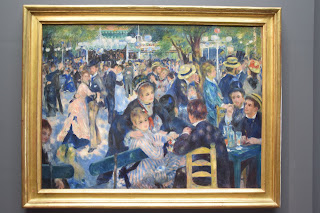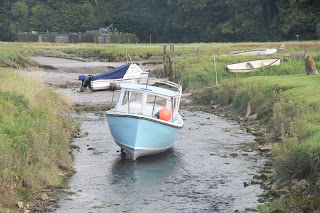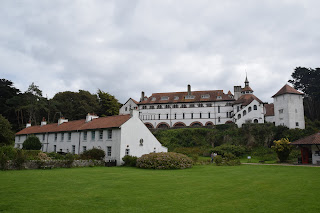Our site ESE of Paris was one of the best caravan sites we have encountered in Europe (Camping 4 Vents). The sites were large and hedged with good facilities, good internet, 15 minutes to the railway station and a non stop half hour train to Garde L’Est. In short – brilliant!
Our first trip into Paris was centered around Montmartre. The temperature was in the 30s so the funicular was the only way to travel up to take in the view from Sacre Coeur. We opted not to queue and go in but set off for a stroll of Renoir's gardens.
The vineyard to one side of the garden is the last one in
Paris. Not sure of the vintage quality but the quantity will be small.
One of Renoirs famous paintings is “The Swing”. This
apparently is the tree and swing (viewed from the other direction). The seat
could be original. The ropes were very worn, hence the supporting spring.
Many of the streets were
dedicated to art and various artists. This display was all about Van Gough.
While this was a wonderful, albeit unusual, display of pottery.
Around Sacre Coeur there are the
inevitable pick pockets and three card tricksters. Away from the crowds there
were further opportunities for thieves – when caught red handed with a fig, theft apparently
becomes scrumping…
Out team had decided our first catch up would be Moulin Rouge. We didn’t
want to be late so we had a perfect reason for a pre-show drink in the adjoining pub. Jo flew in for a few days and as the show was the day prior to her birthday a second celebration was appropriate on the actual day and a quick river trip fitted the bill nicely.
Notre Dame is slowly being repaired after the awful fires of
2019.
As we slipped by Musee D’Orsay (previously
Gare de Paris – Orleans) we were prompted that this was still on our bucket
list and hence became the focal point for the following day.
We started with lunch at the
level 5 café which sits behind one of the wonderful external clocks.
The comparative outside view of the clock helps to underpin the scale of the building.
There were so many well known pictures including one of
Monet’s many versions of 'the haystacks'.
And Renoir’s ‘Dance at the Moulin de la Galette’
As we worked our way through the
artwork it was hard not to be struck by the wonderful conversion from railway
station to museum. The original station was built in 1900 for the ‘exposition’
and was the first station in the world to cater for electric trains. It started
to fall into decline in the middle of the century with the advent of longer
trains as site restrictions prevented the platforms from being lengthened.
In the 1960’s many older
buildings were faced with demolition but due to a lack of exhibition space it
was decided to convert the station to a museum and work got underway in earnest
in 1978.
And what a wonderful job was
done. The old architecture has been refurbished and the new internal areas
designed to enable the original building to be really appreciated. A level 5
viewing platform gives a great overall view.
This closer shot shows off
the detail of the internal clock which appears to have caught the attention of the statue of liberty. (This 1/16 version of the NY statue was
cast in 1900 for the exhibition.)
Natalie had arranged an evening
dinner cruise for us. We had a unique table with petals scattered around supporting
a romantic evening. (Her suggestion that it was an incorrect on-line-booking
box tick was not a believable lie!)
The cruise turn around was by a
second (this time ¼ scale) statue of liberty. There are in fact 5 official
versions in Paris all of which are more correctly called ‘liberty enlightening
the world’ to celebrate the Franco- American relationship.












































